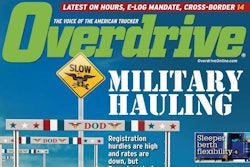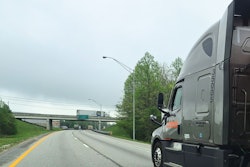If you’re leased to a large carrier, you’ve likely done business with the government on the carrier’s authority. If you’re an independent, odds are you’ve run a brokered load from a Defense Logistics Agency depot or a piece of equipment to or from a fort or training center.
With some exceptions, government freight runs like any other freight. Hours-of-service regulations apply. The usual weight regulations are in effect. You’re often dealing with the same brokers. And, contrary to truck-stop myths, you’ll probably never see black-suited agents swoop down on unsuspecting cops who’ve dared pull over a truck en route to Fort Benning, Ga.
But there are differences in earning potential and entry hurdles, especially for military freight. For some, especially owner-operators with their own authority, significant profit in the military hauling sector has been out of reach in recent years. Leased owner-operators have fared best, as most of the business is scooped up by big carriers that can more easily meet the Department of Defense’s carrier registration requirements and offer rates that generally are lower than those for commercial freight.
Better rates for specialty haulers and teams pulling arms, ammunition and explosives are sometimes seen, but an independent would do well to have his own paper pushers and a truckload of patience to get top dollar.

All federal agencies have hauling opportunities, says Clark Hall, Landstar System’s vice president for government affairs. As a U.S. Army colonel, Hall was chief of staff at the Military Traffic Management Command, now the Surface Deployment and Distribution Command, or SDDC.
For instance, some Landstar owner-operators haul equipment for the U.S. Forest Service in emergency firefighting operations out West, Hall says. “They don’t call very often, but when they do, they really need us.”
The Pentagon, however, is the “big gorilla,” Hall says, and its rates run a wide gamut. Competition for general military freight, classified as FAK (freight of all kinds), is fierce among approved carriers and brokers, but some owner-operators take particular pride in dealing with the military. “Independent truckers are among the most patriotic of Americans out there today,” Hall says.
An independent owner-operator can contract directly under the present system. Joe Whitten of Hartselle, Ala., started his months-long approval process in 2001, during his free time from his factory job, after unsuccessfully trying to find loads in the private sector. The process was “very difficult,” Whitten says, but if the direct connecting opportunity wasn’t open, “it would just have been impossible for me to be in business now.”
After you’ve obtained your own operating authority, the first step in carrier approval is getting a Standard Carrier Alpha Code from the National Motor Freight Traffic Association (website). After that, you should get set up in the PowerTrack program with U.S. Bank, allowing for electronic payments within three days of each shipment.
Next is filling out the registration form. “Our process time is less than two days,” says Anthony Mayo, an SDDC traffic manager.
If a carrier is approved, it must meet a performance bond requirement, which is “definitely the biggest hurdle for a small operator,” says Paul Read, president of Allegheny Surety in Pittsburgh. The bond’s value depends on how many states you want to run Pentagon freight in. For the lower 48 it’s $100,000 for small operations; larger carriers and brokers pay significantly higher amounts for their drivers and clients to run in a smaller number of states.
The cost of the bond’s premium depends entirely on the owner-operator business. An independent owner-operator’s best chance at getting a multi-year bond is to have good credit and a stable business that’s been established for years, Read says. “A national outfit, a big operation, looking for a multiyear bond – they’re going to get it. With a lot of these smaller companies, the surety company is often not certain that these guys will even be around a year from now.”
Towny Sparks, a longtime broker now with Speed Logistics of Kennett, Mo., which specializes in military freight, says setting up took his team eight months. “It’s pretty intense,” he says.
After approval and obtaining the bond, the tender process has to be learned. Carriers and brokers set up their rates, usually according to lane, in SDDC’s Global Freight Management database. Learning that system requires more than a little practice, if not actual training, Sparks says. “And after you factor in all the time we spend on getting the load, it doesn’t seem like something an owner-operator could easily keep up with while he’s out on the road,” Sparks says.
In the 1980s, procurement authority shifted from SDDC to the individual shipping sites as electronic traffic management databases were established, says James Gilmore, chief of Domestic Carrier Services for the command. This Reagan-era decentralization process increased competition and owner-operator opportunity. Now the Global Freight Management system is fully automated and uses an online interface.
“The transportation officer puts in his requirements – the origin, the destination, the nature of what he has to ship, whether that be a can of dog food or an M1 tank,” Gilmore says. “The system massages all that information and spits out a list of carriers that have rates and services on file that he can choose from.”
Competition is heavy. The rules allow you to reduce your rate at any time, but you can raise it only once every two weeks, Sparks says. “Nothing is secret, either,” he says. It’s not uncommon to see similar loads coming out of the same site vary by 50 cents or more per mile from week to week.
“You can see all the other guys’ rates,” says Sparks, “and so it can be extremely difficult to get a good one. I saw some stuff recently that I’d bid much higher on had gone for 70 cents a mile. And we’re not talking about short haul here. This was truckload freight going from Connecticut to California. That won’t hardly even cover your fuel.”
Sparks enters his tenders into the electronic system with a benchmark of no less than 40,000 pounds and a specified per-mile rate per 10,000 pounds from “anywhere to anywhere,” he says. Specifying certain lanes also is possible, if you’re working regionally, which also reduces the value of the performance bond you’ll be required to post.
Whitten took this route. Today he sets up his own tenders and operates mostly in Alabama, Florida, Georgia and South Carolina. The performance bond required of an owner-operator running in up to three states is only $25,000. For up to 10 states, it’s $50,000. But getting a surety company to work with you remains difficult even at the lower levels, Whitten says.
Owner-operator Don Porter of Freistatt, Mo., who’s hauled loads brokered by Sparks and others, says he considered registering with SDDC on his own, but once he saw what was involved, he told himself, “Hell, there’s no way I could do it with just one truck.” He adds, however, that a small-fleet owner-operator with an office to post and adjust tenders could succeed.
Any marketing of services should be directed to the transportation office at installations where shipments originate, or to the contractor who handles the service. At Fort Benning, for example, transportation services are managed by contractor Shaw Infrastructure. Shaw’s Julie Schulz says locally based carriers often have the best rates, but even if they don’t, they sometimes have the edge in reliability.
In Hall’s 30 years with SDDC’s predecessor command, he learned the lowest-cost carrier isn’t always chosen. “Most shippers will select a carrier based on two things – level of service required and cost,” Hall says. “Depending on what the commodity is, there will be a wide variance in the carriers’ rates that are on file. And if they have a high-value piece of equipment they’re really concerned about, they may shy away from going with an extremely low-ball carrier.”
MERCER, LANDSTAR PART OF PENTAGON’S STABLE
Leasing to a carrier registered with the Department of Defense or working through an authorized broker are the two easiest ways into the network for owner-operators looking for business opportunities outside commercial freight, particularly those booking their own loads.
There are 865 motor carriers contracted for domestic transport with the Pentagon, says the U.S. Transportation Command. Among those dealing in relatively large volumes of military freight are Mercer Transportation and Landstar System.
All approved carriers are listed at https://eta.sddc. army.mil. Click “Freight/Cargo,” then “DOD Approved Carrier List.”
CHANGE COULD MEAN MORE – OR LESS – BUSINESS FOR OWNER-OPERATORS
In November, the U.S. Government Accountability Office denied a protest brought by approximately 90 motor carriers, brokers and other parties concerned about a move to consolidate the process for procuring military freight.
That program – the Defense Transportation Coordination Initiative – seeks to contract with a single third-party logistics provider to manage the Department of Defense transportation network. The U.S. Transportation Command will award the contract this year.
Critics say the plan would create a barrier for those looking to do business directly with the Pentagon, but the chief bidders say the ultimate effect would be more hauling opportunity.
Clark Hall of Landstar, which with Mercer and other companies have bid for the contract in a coalition led by UPS Supply Chain, says the change represents an opportunity for both leased and independent owner-operators because the prime transport network manager likely will take on more companies. “It could potentially be even better for small business,” Hall says.
Among the loudest critics is the Transportation Intermediaries Association, an association of freight brokers. “This program creates a virtual monopoly for the mega-contractor awarded the business,” says Earl Eisenhart, the group’s director of government affairs, “and stunts fair market competition because it prevents small business transportation providers from competing directly for Department of Defense business.”
Two other bidders, coalitions led by Ryder System and IBM Global Services, stress their active pursuit of small business involvement. This includes the “incumbents,” as Ryder’s Tim Podvin calls independents who’ve been an integral part of the Pentagon supply chain for years.
“We always look at incumbents, but at the same time, generally, in our solution we’re introducing new providers as well to drive the overall value to our customer,” Podvin says.
IBM’s Walter Kozak says owner-operators should closely watch this process and let the winning bidder know their interest immediately “to ensure they are in fact given every opportunity to play.”
Niche haulers and regional operators stand to benefit from their expertise in certain lanes, Kozak says. Dedicated runs, consolidated truckloads and combined government/commercial freight all are expected to increase along the Pentagon supply chain.
As for rates, look for competition to increase even further, as the initiative is intended to cut long-term costs.
HAVE NICHE, WILL HAUL
Niche haulers can use their expertise as leverage in the competition for Department of Defense freight.
The Pentagon’s Personal Property Program, for example, might suit your operation if you’re pulling a moving van or car hauler. Visit www.sddc.army.mil and click on Personal Property/POV.
Just having special equipment can help. After 26 years driving and doing maintenance in the U.S. Army, Jerry Virgil of Holly Springs, Miss., went out on his own with one truck. Scarcely three years later, J&W Virgil Trucking is a three-truck fleet, hauling weapons on removable-gooseneck trailers.
If you’re a team operation, that’s one hurdle cleared on the way to hauling arms, ammunition and explosives (AA&E). Those hauls are restricted to teams to minimize stops and increase security.
Another is obtaining the correct operating authority – with a bulk-hazmat-type liability insurance requirement of $5 million instead of the $1 million required of most general military freight.
To haul AA&E, an owner-operator team must undergo individual background checks through the Defense Security Service, which works with the Surface Deployment and Distribution Command to get clearances for the drivers at each facility that must be entered. The command requires “total in-transit visibility, satellite tracking, the latest technologies that are out there,” says James Gilmore of the SDCC.
Only about 30 carriers nationwide are approved to haul AA&E. One of them, Baggett Transportation, was founded in 1928 as a local hauler of dynamite for coal companies around Birmingham, Ala. Today, Baggett’s single-driver owner-operators start around 95 cents a mile, but its arms-hauling teams start at $1.40, says Claiborne Crommelin, the fleet’s vice president for safety. The company currently contracts with about 70 owner-operator teams for AA&E.
Mercer has 75 approved AA&E teams, says Vice President Jack Lubay. Landstar has upward of 400, Clark Hall says.
Rates can vary wildly depending on the cargo, but Landstar team Joe Griggs and Sandy Hart, nearing retirement after 18 years hauling weapons, have seen colleagues in AA&E exceed $350,000 in gross yearly earnings.
After his three-truck fleet became an approved carrier, owner-operator Joe Whitten landed his first Pentagon haul using the Spot Bid function in the Electronic Transportation Acquisition system. Spot Bid, reserved for time-sensitive and oversized shipments, allows real-time bidding on specific loads.
Whitten landed five shipments going from Chipley, Fla., east to a base nearly four hours south of Jacksonville. He had to deadhead to Chipley from his home in northern Alabama, but “I had made up my mind that if it cost me money, I was going to complete that shipment,” Whitten says.
Since then, his regional dedication and further familiarity with the Global Freight Management system have allowed him to be successful on his own.
FOR MORE INFORMATION
Defense Transportation Coordination Initiative
http://dtci.transcom.mil
Ryder System
www.ryder.com
IBM Global Services
www.935.ibm.com/services/us
UPS Supply Chain
www.ups-scs.com
COMPETITION DRIVING DOWN SOME RATES
Dozens of loads of weapons and equipment move through the Anniston Army Depot gates in Alabama every day, thanks to certain fleets that maintain facilities nearby. Baggett Transportation, for instance, has an installation for its munitions haulers. So does Landstar Ranger.
Pate Morrison, a Landstar Ranger agent at “Ranger Station” on Alabama Highway 202 and owner of a small fleet based there, started doing business with the military in the late 1960s when he was selling sack coal at a service station he owned. “Somehow we got a contract to furnish them coal one winter,” he recalls. After selling the service station in the early 1980s, he went full time with Ranger Transportation, which became Landstar Ranger in 1988.
Ranger Station is base for more than 60 Landstar owner-operators hauling FAK (freight of all kinds) and munitions, among some commercial loads as well, out of Anniston. Morrison says rates have been declining for three years, since the military’s Tailored Transportation Contract program has drawn more third-party logistics firms to FAK. 3PLs such as Blue Wing Express and Eagle Global Logistics secure dedicated lane contracts and drive down rates, Morrison says.
Morrison cites an extreme low-ball example: FAK moving 776 miles at gross revenue of $1,124. Even if the owner-operator moves it with his own trailer and keeps 75 percent, that’s gross revenue of only $1.09 per mile.
On a recent Tuesday, owner-operator Joe Rogers was doing paperwork at Ranger Station before hauling an FAK load just under 400 miles to the Lexington Army Depot in Kentucky. He uses that fairly regular haul to put him near a Johnson Controls plant, from which he hauls batteries to a General Motors facility in Atlanta.
“That puts me home every weekend, and I’m back out after church on Sunday,” says Rogers, who lives close to the depot. It took him years to get the set-up. He formerly ran east to west and typically was out six to eight weeks at a time. Today, with his partially dedicated haul, he nets around $55,000 to $60,000 a year, he says.
Morrison is the agent on a dedicated Landstar lane for van freight from Anniston to the New Cumberland Army Depot near Harrisburg, Pa. A few times a week Danny Gooden, a driver for Morrison and a Landstar inspector, runs empty to the Anniston depot. The military loads his van, which he drops back at Ranger Station. An over-the-road Landstar owner-operator hooks the load later.
Since the Sept. 11 attacks, “security is much tighter in many ways,” says owner-operator Sandy Hart, who hauls munitions with her partner, Joe Griggs. They stopped at Ranger Station before heading off to parts known only to military brass, the agent on the load and themselves.
“We don’t work a whole lot,” says Hart, who expects to retire with Griggs within two years. “Some of the teams really put the miles and the money down – anywhere from $350,000 to $400,000 a year, gross.” Hart says she and Griggs have gotten everything they’ve wanted at this point, including a 180-inch bunk they added to their 1994 Kenworth W900 in 2001.
SAMPLE MILITARY PER-MILE RATES
These loads originated at the Anniston (Ala.) Army Depot in March.
AA&E: The rates are based on a single main driver team, though a second security-cleared driver team hauling an empty trailer as an escort was likewise required on this load. Per estimates, the escorts made $1.75 per mile.
SPOT BID: The rate is higher because the load was oversized; in such cases, the Pentagon pays extra to ensure against lost time.
FAK: The freight of all kinds load is ordinary except for extra security at entrances.
Fuel surcharges are included in rates. Rates exclude the PowerTrack freight payment program’s 1 percent deduction.













